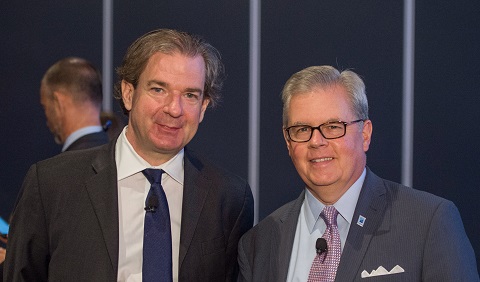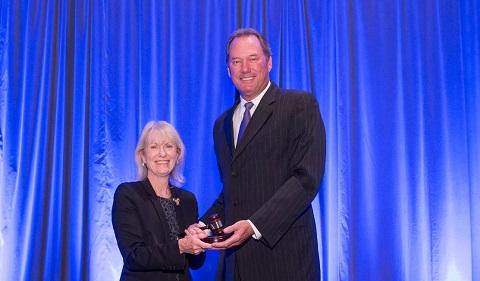William E. Downes Jr. Memorial Award Winner: Louis E. Miller
After a deep and
thought-provoking keynote address by CNN National Security Analyst Peter
Bergen, General Session II attendees were able to witness a great man receiving
ACI-NA’s most prestigious award. Louis E. Miller is this year’s recipient of
the William E. Downes Jr. Memorial Award, awarded for his outstanding leadership
and action in the cause of airport or aviation management. The award was
presented by Bill Vanecek, Chair of ACI-NA.
Prior to Mr. Miller
taking the stage to accept his award, attendees were shown a remarkable video
complete with numerous testimonies from aviation industry professionals close
to him. Each testimony included memories of Mr. Miller and his success that
drew chuckles from attendees.
Mr. Louis Miller took
the stage amid much applause to accept his award, and no one was more deserving
than him.
|
On
behalf of Aéroports de Montréal, President and CEO Jim Cherry accepted the
2016 Host Airport Award during the ACI-NA membership meeting at the 2016
ACI-NA/World Annual Conference.
|
Twenty North American Airports Recognized for
Airport Carbon Accreditation
Yesterday, Airports
Council International – North America (ACI-NA) recognized the 20 North American
airports to achieve Airport Carbon Accreditation during the 2016 ACI-NA/World
Annual Conference. Read the full release >>
|
Adding to the Bottom Line by Enhancing the Passenger Experience
"Does it really matter
which bottom line?" Romesh Bhoyroo, CEO, Sir Seewoosagur Ramgoolam
International Airport Mauritius began the session by posing this question to
attendees.
Running a modern
airport is no easy task, as they are very complex in an already competitive
market. One of the most important objectives for an airport is to satisfy its
customers, which leads to more revenue. However, the first step toward
passenger satisfaction is to understand their wants and needs.
Each of the panelists
from this session represented very different airports, but all of them agreed
that data mining is a key element of passenger satisfaction. Tampa
International Airport was the first airport to add a people mover for
passengers over forty years ago, as a result of finding out how little
customers like to walk.
It is quite a challenge
to provide the same experience for travelers that they receive at large hubs
like Dubai International Airport or Charles de Gaulle Airport, at small
airports. Panelist Romesh Bhoyroo can attest to that. Small airports may not
have as much to offer passengers as large airports do, but they can manage to
keep them happy. One way Sir Seewoosagur Ramgoolam International Airport is
able to keep its customers happy, is by utilizing its Outstanding Passenger
Service Excellence program that pushes airport personnel to go above and beyond
to satisfy customers. The human touch can go a long way when it comes to
finding out what customers want and need, especially as passenger behavior
continues to change.
Panelists Joyce Carter,
President and CEO, Halifax International Airport Authority, Romesh Bhoyroo, and
Joe Lopano, CEO of Tampa International Airport, understand the importance of
gathering data in order to better understand passengers. They each spoke a lot
about the use of surveys to help with information gathering. Simple questions
such as age, gender, and income can make a difference in a customer’s
happiness. Passengers are the life blood of an airport; therefore, their
satisfaction is vital to an airport’s overall success.
|
Breaking Down the Silos on Safety
A lack of
cooperation between people on the ground and people in the towers can cause
fatalities, said Moderator Bongani Maseko, CEO, Airports Company South Africa,
at the Breaking Down the Silos on Safety session. "At one time, we did not talk
directly to pilots." They were known as the invisible partners, he said.
Thankfully, things have changed and now we all try to work together in this
congested space. But, making the merge isn’t easy.
Rob Eagles,
Director Air Traffic Management, IATA, said, "I think we’ll all agree that we
do have silos in our industry.... But, it is absolutely critical that we learn to
work together as stakeholders. And we have to be careful not to add new silos."
Eagles specifically addressed the risks associated with RPAS/UAS/drones,
stressing the need to address safety risks related to "irresponsible users."
Andrella
Kenner, Founder & President, CI2 Aviation, talked about runway safety. "A
failure to deliver safe runway operations is almost always catastrophic," she
said. She stressed the importance of situational awareness and having a
checklist every day.
Dirk
Geukens, Senior Safety Expert, Brussels Airport, discussed apron safety
collaboration. "Most of the damages to aircraft are when they are parked and
handling activities are going on," he explained. Coordination is very important
in these busy, congested areas. One of the ways they addressed this? Safety
Committees. "One of the major pillars of a safety management program is having
safety committees," he said. They have an apron safety committee called
BRUTuS (BRUssels Turnaround Safety TF) that has the
objective of analyzing and documenting every apron operation.
Eduardo
Angeles, Associate Administrator of Airports, FAA, commented on the discussion
points brought up by the other panel speakers, as well as gave a summary of
some of the items on the FAA "to do" and "done" lists. He explained that UAS
was a number one issue around the world at the moment. Also, "We did a runway
safety program... that was extremely successful" and took place over 15 years.
And, they are in the process of "investing a lot of money into about what
causes runway incursion and mitigation."
|
Respond to New and Emerging Security Threats
"None of us
can do the job of effective security by ourselves," said Vera Adams, Director,
Director, Aviation Division, Office of Security Policy and Industry Engagement,
TSA. "We have to work in a very integrated fashion."
During the
Respond to New and Emerging Security Threats session moderated by William
Vanecek, Director of Aviation, Niagara Frontier Transportation Authority, many
such valuable suggestions such as this were shared by the panelists.
Adams
stressed the importance of having security policies that could be implemented,
were practical and were going to be effective. She also brought up the need to
have complementary programs, ones that weren’t "at odds with each other, or we
run risk of being ineffective and inefficient." Adams touched on ideas
currently being used, or in the works, as well. She encouraged everyone to sign
up for the Rap Back program, which is a "perpetual vetting process for
employees." And, she definitely encourages the use of biometrics. "Biometrics
are a really good upgrade for access controls."
Neil Perry,
Vice President, Service Delivery, CATSA, explained that all organizations
manage risk and some assess threats - threat of completion, threat of market
fluctuations, etc. We break down physical threats, aviation security and
explosive threats, he said. "We don’t do it alone, however. There are
partnerships." He said that to assess the risk of threats, "you rely on
intelligence." Once they have all the information, you have to analyze it. The
CATSA Threat Detection Baseline defines minimum threat detection standards,
focuses on historical and current trends, and is adjusted, as necessary. "New
ones come along, but we can’t stop looking at the old ones either," he
explained.
This
important aspect was reinforced by Jim Marriot, Aviation Security at ICAO. "It
is very tempting to be attracted to the new emerging threats and forget about
the previous ones," he said. "Threats don’t go away. They’ve been successful in
the past, they’ll be tried again. It is not a list of threats where you add a
new one and then you take one off." He said the challenge that ICAO has "is
like the challenge you have at your airport. We have a lot of different players
that need to be organized and aligned to achieve results." And there has been
strong progress made recently. The first-ever Global Aviation Security Plan is
being proposed at ICAO. "It will be a priority," he said. And, last week,
the United Nations adopted an aviation security program (available on the
Security Council website). This is another validating example of the fact that
there is now "a strong rudder guiding aviation security."
|
Just
because you're at a conference doesn't mean the world stops. This section will
feature the latest industry news so you don't miss a beat while networking with
old friends and new connections.
Hartsfield-Jackson
joins industry effort to improve security screening process: Hartsfield-Jackson
International has signed on to an airport industry project aimed at improving
the security screening process, becoming the first U.S. airport to participate.Read
more >>
FAA touts Data Comm
installations at 45 U.S. airport ATC towers: Enabling controllers at airport
air traffic control (ATC) towers to transmit flight clearance information to
pilots via text message will reduce flight delays and potentially expand
capacity at crowded airports, according to FAA. The agency demonstrated the
technology for media Sept. 27 at Washington Dulles International Airport (IAD).Read
more >>
House passes bill to
ensure breast milk is allowed on airplanes: House lawmakers Tuesday easily
passed a bill ensuring that passengers traveling with infants can bring baby
bottles and breast milk through airport security. Read
more >>
Clinton, Trump bring infrastructure
hopes to White House: Whether it’s Hillary Clinton or Donald Trump in the
White House next year, one thing is certain: Infrastructure spending is going
to be on the agenda. Read
more >>
Trump compares U.S. airports to 'third-world country': On Monday Donald Trump lambasted the state of
American infrastructure at the first presidential debate, comparing a major New
York airport to a "third-world country." Read
more >>
Delta, Air France-KLM
and Jet Airways to expand codeshare from CDG: Atlanta-based Delta Air Lines
and joint venture partner Air France-KLM have announced an expansion of the
airlines’ existing cooperation agreement with India’s Jet Airways. Read
more >>
Lehigh Valley
residents can sign up for TSA program at LVIA to bypass security lines: For
the first time, Lehigh Valley International Airport is offering a TSA Precheck
program that allows qualified fliers to bypass the main checkpoint line. Read
more >>
WestJet, Air Canada
facing lawsuit over bag fees: Canada’s two major airlines, WestJet and Air
Canada, are facing accusations they worked together in imposing fees for
checked bags. Read
more >>
KCI’s passenger
traffic up again in August over last year: Passenger traffic at Kansas City
International Airport has increased 5.6 percent for the year through August
compared with the same period last year, the city’s Aviation Department said
Tuesday. Read
more >>
|


.png) Be sure to tweet comments and photos from the
2016 ACI-NA/World Annual Conference/World Annual General Assembly. Mention @airportscouncil and use the hashtag #airports16 Be sure to tweet comments and photos from the
2016 ACI-NA/World Annual Conference/World Annual General Assembly. Mention @airportscouncil and use the hashtag #airports16
|
Keynote Address with Peter Bergen
On 9/11,
there were only 16 people on the No-Fly List, said CNN’s National Security Analyst Peter Bergen. Now, there are thousands on this list. Those numbers speak volumes about how serious the terrorist threat
danger is at airports and how seriously the United States federal
government's Terrorist Screening Center (TSC) is addressing the threat.
Bergen, who
has been part of this security discussion for more than two decades, shared his
perspective on this topic during the keynote presentation on Tuesday. "Aviation
security is the top national security issue," he said. "They remain the Holy
Grail and that is not to change any time soon. They are going to find the weakest
links in the systems and are going to try to attack them."
And there
isn’t much you can do to discourage them trying to target you. "They are not
going to target bus stations in the same way," he explained. "You can push back
the perimeter, but you are just pushing back the problem." He mentioned an
interesting idea he saw in Turkey, where your entire car has to go through an
X-ray-type machine. But, then is this long of cars creating another target,
similar to the long queue lines at gate security checkpoints?
The main
security issue facing airports now is the insider threat, he said, as we saw
with the Metrojet attack in Egypt last year -- the deadliest attack on aviation
since 9/11. Also, not just airline or airport personnel are involved. As a
recent example, he mentioned an incident at Heathrow where someone in the
shopping area was in contact with a terrorist group. "The problem is people who
are being radicalized and being radicalized very quickly," said Bergen.
"Internet is radicalizing people and there is not a lot you can do except put
better media out there."
The other
problem is that if we destroyed ISIS tomorrow, "that would not be solving the
problem. ISIS is the symptom of a deeper problem that is not going away anytime
soon." He explained that ISIS has lost 45,000 fighters in the past two years
and are no longer able to replenish themselves. But, before long, "there will
be a son of ISIS or sons of ISIS."
Also, what
happens as ISIS is increasingly put under pressure and defeated? What happens
to the foreign fighters? They will disperse and have nowhere to go, said
Bergen. "What kind of threat do they pose?"
Terrorists
are also acquiring armed drones and are becoming their own media network. "ISIS
is broadcasting attacks in real time," said Bergen. "It is a sobering
development.’
On a good
note, however, "the fact is, the U.S. government has done a good job of keeping
us safe, as have the people in this room," said Bergen. Will there be more
attacks? Yes. But, we have made it "much, much harder for terrorists to attack
the United States," said Bergen.

|

ACI-NA Celebrates Leadership
Rotation at Annual Conference
Airports Council International - North
America (ACI-NA) announced yesterday that William (Bill) Vanecek, Director of
Aviation at Buffalo Niagara International Airport, assumed the chair position
for the organization’s Board of Directors from outgoing Chair Maureen Riley,
Executive Director of Salt Lake City Department of Airports. The change in
leadership happened during a special reception on Tuesday, September 27, 2016, at the ACI-NA/World Annual Conference and World Annual General Assembly in
Montréal.
"ACI-NA has an ability to bring
together the industry to find common sense solutions to challenges we face as
airport operators," said Vanecek. "As the next chair of ACI-NA, I am looking
forward to working alongside airport leaders to advance important airport
priorities in Washington and Ottawa."
|
|
| |
|

